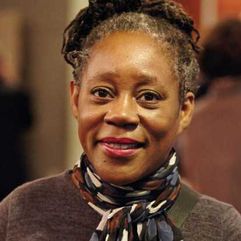

Sonia Boyce
1962 - Present
She works with a range of media including photography, installation and text. She gained prominence as part of the Black British cultural renaissance of the 1980s. Her work also references feminism. Ron Exley has written: “The effect of her work has been to re-orientate and re-negotiate the position of Black or Afro-Caribbean art within the cultural mainstream.”
An early exhibition in which she participated was in 1983 at the Africa Centre, London, entitled Five Black Women. Boyce's early works were large chalk-and-pastel drawings depicting friends, family and childhood experiences. Drawing from her background she often included depictions of wallpaper patterns and bright colours associated with the Caribbean. It has been suggested that through this work the artist examined her position as a black woman in Britain and the historical events in which that experience was rooted.
In her later works Boyce used diverse media including digital photography to produce composite images depicting contemporary black life. Although her focus is seen to have shifted away from specific ethnic experiences, her themes continue to be the experiences of a black woman living in a white society, and how religion, politics and sexual politics made up that experience.
She has taught widely and uses workshops as part of her creative process, and her works can be seen in many national collections. Boyce's works are held in the collections of Tate Modern, Victoria & Albert Museum, the Government Art Collection, British Council and the Arts Council Collection at Southbank Centre.
Sonia Boyce was awarded an MBE in the Queen's Birthday Honours List 2007, for services to art. In 2016, Sonia Boyce was elected as a member of the Royal Academy.
Boyce created a 1.8-kilometre mural in London in 2018.
She was appointed an Officer of the Order of the British Empire (OBE) in the 2019 New Year Honours for services to Art.
[above text from Wikipedia]



